Educators are increasingly recognizing the importance of integrating First Nations perspectives into classroom instruction as a means of broadening students’ understanding and appreciation of indigenous cultures and histories. This integration can provide a more comprehensive and inclusive educational experience for all students, promoting respect and reconciliation between indigenous peoples and wider community members.
Incorporating First Nations perspectives into the classroom not only enriches the educational journey but also acknowledges the traditional custodians of the land on which schools operate. It helps in rectifying historical omissions and inaccuracies about First Nations people within mainstream education systems. To genuinely embed these perspectives, several strategies can be adopted:
Curriculum Design:
A starting point is the development of a curriculum that includes First Nations histories, cultures, languages, and contemporary issues. This principle applies not only to subjects like history or social studies but can also be woven into science (indigenous knowledge systems), literature (First Nations authors), and even mathematics (patterns in art).
Community Engagement:
Engaging with local First Nations communities is crucial. Partnerships can lead to co-created programs, inviting elders and knowledge keepers into schools to share oral histories, participate in ceremonies or assist with language programs.
Professional Development for Teachers:
Teachers need proper training to incorporate First Nations perspectives effectively. This includes learning about cultural sensitivity, historical contexts, teaching techniques that honor oral traditions, and being comfortable with addressing complex topics like colonization.
Creating Inclusive Environments:
The classroom environment itself should reflect First Nations cultures visible through artwork, maps, flags, or resources made available. Celebrating significant dates for First Nations communities can also foster inclusivity.
Active Participation in Reconciliation Activities:
Schools play a key role in fostering reconciliation between indigenous peoples and non-indigenous Australians. Educational institutions can encourage student participation in events like National Reconciliation Week or NAIDOC (National Aborigines and Islanders Day Observance Committee) Week.
Resource Development:
Developing teaching materials that accurately represent First Nations perspectives requires collaboration with First Nations educators and organizations to ensure cultural appropriateness and accuracy.
Student-Centered Learning Approaches:
Encouraging students to take the lead creates an environment in which they learn directly from First Nations individuals and resources, delving into projects that are both meaningful and informative.
Assessment Adaptation:
Assessments should allow students to demonstrate their understanding of First Nations perspectives through a variety of methods such as storytelling, art projects, or community involvement activities.
By actively engaging with these strategies, educators will not only pay homage to the traditional owners of the land but will also contribute significantly to the development of well-rounded students who are better prepared as global citizens with a deep respect for diversity and history. Embedding First Nations perspectives is more than an educational preference; it’s a commitment to social justice and equity within the schooling system.





